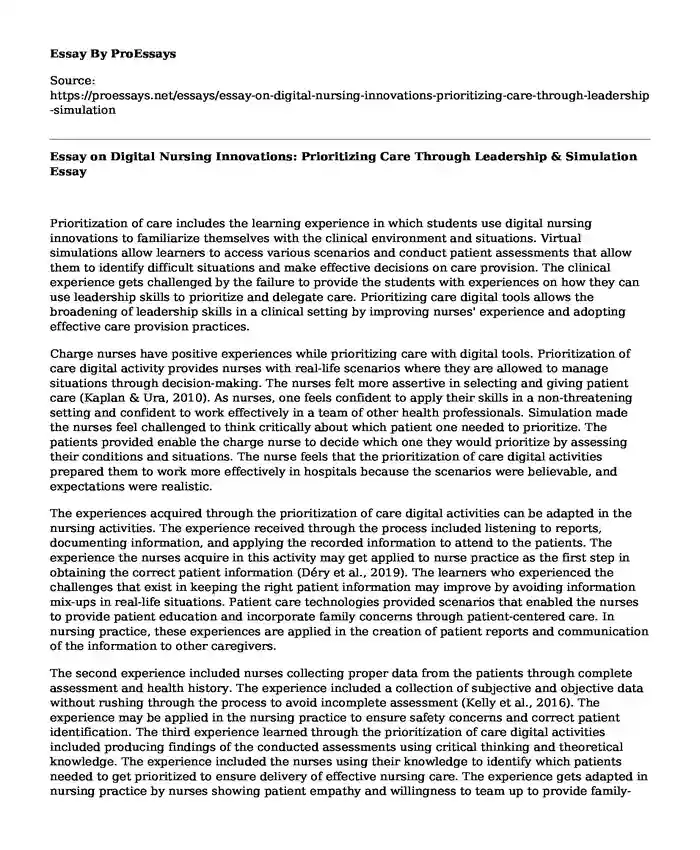Prioritization of care includes the learning experience in which students use digital nursing innovations to familiarize themselves with the clinical environment and situations. Virtual simulations allow learners to access various scenarios and conduct patient assessments that allow them to identify difficult situations and make effective decisions on care provision. The clinical experience gets challenged by the failure to provide the students with experiences on how they can use leadership skills to prioritize and delegate care. Prioritizing care digital tools allows the broadening of leadership skills in a clinical setting by improving nurses' experience and adopting effective care provision practices.
Charge nurses have positive experiences while prioritizing care with digital tools. Prioritization of care digital activity provides nurses with real-life scenarios where they are allowed to manage situations through decision-making. The nurses felt more assertive in selecting and giving patient care (Kaplan & Ura, 2010). As nurses, one feels confident to apply their skills in a non-threatening setting and confident to work effectively in a team of other health professionals. Simulation made the nurses feel challenged to think critically about which patient one needed to prioritize. The patients provided enable the charge nurse to decide which one they would prioritize by assessing their conditions and situations. The nurse feels that the prioritization of care digital activities prepared them to work more effectively in hospitals because the scenarios were believable, and expectations were realistic.
The experiences acquired through the prioritization of care digital activities can be adapted in the nursing activities. The experience received through the process included listening to reports, documenting information, and applying the recorded information to attend to the patients. The experience the nurses acquire in this activity may get applied to nurse practice as the first step in obtaining the correct patient information (Déry et al., 2019). The learners who experienced the challenges that exist in keeping the right patient information may improve by avoiding information mix-ups in real-life situations. Patient care technologies provided scenarios that enabled the nurses to provide patient education and incorporate family concerns through patient-centered care. In nursing practice, these experiences are applied in the creation of patient reports and communication of the information to other caregivers.
The second experience included nurses collecting proper data from the patients through complete assessment and health history. The experience included a collection of subjective and objective data without rushing through the process to avoid incomplete assessment (Kelly et al., 2016). The experience may be applied in the nursing practice to ensure safety concerns and correct patient identification. The third experience learned through the prioritization of care digital activities included producing findings of the conducted assessments using critical thinking and theoretical knowledge. The experience included the nurses using their knowledge to identify which patients needed to get prioritized to ensure delivery of effective nursing care. The experience gets adapted in nursing practice by nurses showing patient empathy and willingness to team up to provide family-centered care. Finally, the virtual simulation on patient care technologies provided insight into the shift of responsibilities when prioritizing care according to patient’s information (Kaplan & Ura, 2010). The experience may improve nursing practice by utilizing resources and knowledge to provide care where it is most needed.
Conclusion
In conclusion, the Sentinel hospital transformation of nursing education through virtual simulations improves the nurse's critical decision-making process. Prioritizing care digital activities provides the students with the needed learning scenarios that help them identify the issues that exist in providing effective care. The learners get immersive experience through virtual simulations that enable them to overcome challenges in prioritizing care and managing patients.
References
Déry, J., Ruiz, A., Routhier, F., Gagnon, M. P., Côté, A., Ait-Kadi, D., ... & Lamontagne, M. E. (2019). Patient prioritization tools and their effectiveness in non-emergency healthcare services: a systematic review protocol. Systematic reviews, 8(1), 1-7. https://systematicreviewsjournal.biomedcentral.com/articles/10.1186/s13643-019-0992-x
Kaplan, B., & Ura, D. (2010). Use of multiple patient simulators to enhance prioritizing and delegating skills for senior nursing students. Journal of Nursing Education, 49(7), 371-377. https://pdfs.semanticscholar.org/ee59/6a2099a1d9407fcb4a8f0ceace42fac11ea2.pdf
Kelly, M. A., Berragan, E., Husebø, S. E., & Orr, F. (2016). Simulation in nursing education—International perspectives and contemporary scope of practice. Journal of Nursing Scholarship, 48(3), 312-321. https://sigmapubs.onlinelibrary.wiley.com/doi/abs/10.1111/jnu.12208
Cite this page
Essay on Digital Nursing Innovations: Prioritizing Care Through Leadership & Simulation. (2023, Nov 03). Retrieved from https://proessays.net/essays/essay-on-digital-nursing-innovations-prioritizing-care-through-leadership-simulation
If you are the original author of this essay and no longer wish to have it published on the ProEssays website, please click below to request its removal:
- Child's Developmental Needs - Paper Example
- Tranexamic Acid Use in Traumatic Brain Injury and the Need for Blood Transfusion
- Type 2 Diabetes, Hypertension, Heart Disease and Obesity Essay
- Evidence-Based Obesity Prevention in Childhood Essay Example
- Medical Marijuana Should Be Used in Medicine Essay
- Ecological Crisis: Insufficiency of Dominant Modes of Thought - Essay Sample
- Whole 30 Diet Program: Avoiding Health Issues & Living a Healthy Life - Essay Sample







